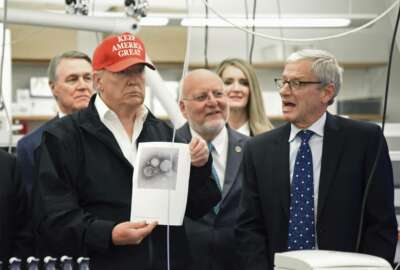Citing the safety and wellbeing of its employees amid the coronavirus threat, the Postal Service has released its 2020 Pandemic Influenza Plan, which sets “a baseline of Postal Service policies and procedures for preparedness, response and recovery from any infectious disease outbreak.”
USPS Chief Human Resources Officer Isaac Cronkhite, in a memo to employees sent last Friday, said some of the guidance isn’t specific to the COVID-19 outbreak, but added that the policies and procedures are “generally applicable to a potential COVID-19 pandemic, pursuant to the current advice provided by the Centers for Disease Control and Prevention (CDC).”
“Headquarters will issue additional detailed guidance on continuity of operations and human resources considerations during a pandemic as necessary and relaying further information provided by the CDC as it develops,” Cronkhite wrote in the memo.
In addition to the Pandemic Influenza Plan, USPS has also released interim measures more specific to COVID-19, the name of the illness caused by the current strain of the coronavirus.
In communities without a confirmed COVID-19 case, USPS urges postal employees to stay home if they’re sick or have coronavirus symptoms, such as fever, cough and shortness of breath.
While the CDC doesn’t recommend healthy individuals wear face masks to avoid catching COVID-19, the Postal Service, per the memo, will provide surgical masks to postal employees upon request.
If coronavirus hits a local community, USPS urges facility medical personnel, working with installation heads or attendance control officers, to monitor sick leave for “observable trends that may indicate a COVID-19 outbreak among postal employees.”
“Personnel who arrive at work obviously ill, or who become ill at work with COVID-19 type symptoms should be released from work,” the memo states. “Such individuals should be advised to remain off work until they no longer have these symptoms. A medical clearance may be required from an absence actually related to COVID-19.”
If a postal employee or an immediate household member exhibits COVID-19 symptoms, the memo urges “social distancing,” or maintaining a three-to-six foot distance between employees and customers.
Where appropriate and feasible, the memo also urges telework, alternative work locations or alternative work schedules “to ensure that work is performed in the safest manner possible for employees and customers.”
At least one postal employee has been diagnosed with the coronavirus. According to the National Postal Mail Handlers Union, a USPS Network Distribution Center employee in Seattle tested positive on Feb. 29 after extended overseas travel.
NPMHU President Paul Hogrogian and other union leaders met with Postmaster General Megan Brennan and USPS senior leadership on March 3 to discuss methods to prepare for the coronavirus.
A USPS spokesman told Federal News Network that the Postal Service will continue to recommend strategies from the CDC and public health departments.
“The safety and wellbeing of U.S. Postal Service employees is our highest priority,” the spokesman said.
In addition, USPS will share CDC’s guidance to its employees through stand-up talks, articles, messages on bulletin boards and internal messaging inside USPS workplaces.
Because of widespread airline cancellations and travel restrictions to China and Hong Kong, USPS on Feb. 10 temporarily suspended its guarantee on Priority Mail Express International destined for those areas.
Customers may see delays in mail and packages to and from China, but the USPS spokesman said the Postal Service “is undertaking all reasonable measures to minimize the impact to our customers.”
The CDC advises that there is “likely very low risk” that COVID-19 can spread from packages shipped from China, “because of poor survivability of coronaviruses on surfaces.”
The CDC has also found that there is currently no evidence that would suggest that COVID-19 can spread from imported goods. The agency has noted there are no reported cases of COVID-19 in the United States associated with imported goods.
Copyright
© 2024 Federal News Network. All rights reserved. This website is not intended for users located within the European Economic Area.
